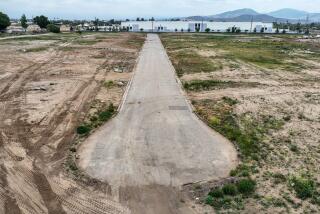Conservationists Attack Jordan Report : Environment: Two groups say the land-swap study is flawed because it doesn’t assess impacts of the development tied to the deal.
- Share via
An environmental report considered “very favorable” to an exchange of 59 acres of federal parkland for portions of the Jordan Ranch in eastern Ventura County is legally flawed because it does not assess the impacts of a large development tied to the swap, two conservation groups charged Friday.
Because of its narrow focus, “we feel it’s a whitewashed report,” said Mary Wiesbrock, chairwoman of the environmental group Save Open Space, which opposes the swap. “It leaves wide open the possibility of a lawsuit.”
Donald Hellmann, an attorney for the Washington-based Wilderness Society, agreed. But, like Wiesbrock, he stopped short of saying whether the two organizations will join forces in filing a lawsuit against the National Park Service.
“We’re keeping our options open,” said Hellmann, whose group includes 400,000 members nationwide. Wiesbrock’s group includes about 200 members from Ventura and Los Angeles counties.
William Webb, deputy superintendent of the Santa Monica Mountains National Recreation Area, said that Park Service lawyers reviewed and approved the scope of the study before it began.
“It is legally sufficient,” he said.
A copy of the environmental impact statement prepared for the Park Service was reviewed by The Times. The report will be circulated to the general public next week.
The fact that the report does not include the impact of the 750 houses and championship golf course planned for Jordan Ranch has been a point of contention ever since the environmental process began two years ago.
Wiesbrock and Hellmann said the report is inadequate because its focus is limited to the exchange of 59 acres of Park Service land in Cheeseboro Canyon for 864 acres of the 2,308-acre Jordan Ranch, owned by entertainer Bob Hope. The land is needed for an access road to the development planned for another section of the ranch.
Wiesbrock said the Park Service report on the land exchange should have been combined with the separate environmental impact report on the Jordan Ranch project. The report on the development said it would cause “unavoidable and significant impacts” on air quality, traffic and the area’s rural environment.
“It’s going to devastate the whole area,” Wiesbrock said.
The Park Service report, which neither endorses nor opposes the land swap, said that if the exchange takes place and the access road is built, the oak-dotted, 59-acre tract would no longer be available for public recreation.
However, the report states that the land deal offers benefits to the Park Service because development of the larger 864-acre tract would be foreclosed.
The report also notes Hope’s offer to sell or donate an additional 4,800 acres of his mountain property to park agencies for a below-market $10 million if the Jordan Ranch development and land swap are approved.
As for the planned development, the report simply states that the impacts generated by the project are addressed in the environmental impact report prepared by Ventura County.
“The documentation in the EIS is very favorable to the proposed swap,” Mike Hayden, a top official with the U.S. Interior Department, said this week in a prepared statement released in Washington.
Hayden’s remarks angered opponents of the land exchange, who said that the department has not adhered to its official position of neutrality on the swap. Earlier this year U.S. Interior Secretary Manuel Lujan sent a letter to Gov. Pete Wilson calling the land swap “personally attractive.”
However, Lujan has said that the Park Service’s decision on the land swap ultimately hinges on what the Ventura County Board of Supervisors decides on the Jordan Ranch development. The board is expected to review the development in early January. A majority of board members have already said they would reject the project as it is now proposed.
“They see Ventura County being the weak link in the chain,” Hellmann said of the Park Service. “And they are going to do whatever they can to make sure the county goes along with their plans.”
Wiesbrock and Hellmann said they oppose the land swap because it would set a dangerous precedent by opening up the doors to development in all national parklands.
However, some conservation groups have come out in support of the deal, saying it is a unique opportunity to acquire land that otherwise would not be obtainable because of a shortage of public funds.
If the Jordan Ranch development is rejected by the county, the city of Simi Valley has said it is interested in annexing Jordan Ranch. Simi Valley officials said they favor the deal because Los Angeles County now plans to build a landfill on part of Hope’s property near the city.
More to Read
Sign up for Essential California
The most important California stories and recommendations in your inbox every morning.
You may occasionally receive promotional content from the Los Angeles Times.










